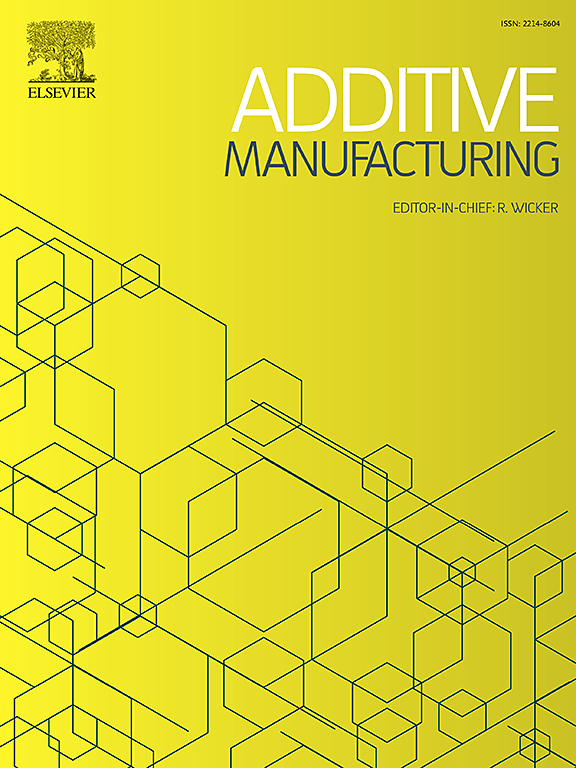通过冲击旋磨回收镍铝青铜磨屑作为定向能沉积的原料:加工性能、微观结构和力学性能的研究
IF 11.1
1区 工程技术
Q1 ENGINEERING, MANUFACTURING
引用次数: 0
摘要
在船舶螺旋桨的生产过程中,需要生产大量的镍铝青铜研磨片。本文研究了通过冲击旋转铣削对这种切屑进行机械粉碎,并利用两种切屑粉末批作为激光定向能沉积工艺的原料。通过数字图像分析、标准化流动性测试、扫描电子显微镜和能量色散x射线光谱学对材料进行了表征,并与传统的气体雾化粉末进行了比较。对定向能沉积试样的密度、硬度和显微组织进行了分析,并对垂直和水平方向的拉伸性能进行了比较。在较高的磨机转速下,冲击旋磨粉碎产生的颗粒呈圆形,具有良好的流动性能和粒度分布,适合沉积添加剂样品。由于增材制造工艺的高冷却速率,其显微组织呈现出特有的马氏体相。在粉末和拉伸断口表面均观察到陶瓷夹杂物的存在,部分影响了力学性能。然而,垂直堆积方向(Z)的试样表现出竞争拉伸结果,抗拉强度为775 MPa,屈服强度为455 MPa,断裂伸长率为12.6 %。本研究的结果表明,将加工芯片回收为增材制造原料可以是降低材料成本和环境影响的可行选择。本文章由计算机程序翻译,如有差异,请以英文原文为准。
Recycling nickel aluminium bronze grinding chips to feedstock for directed energy deposition via impact whirl milling: Investigation on processability, microstructure and mechanical properties
During the production of ship propellers, considerable quantities of grinding chips from nickel aluminium bronze are produced. This paper examines the mechanical comminution of such chips via impact whirl milling and the utilization of two chip-powder batches as feedstock for a laser-based directed energy deposition process. The materials are characterized via digital image analysis, standardized flowability tests, scanning electron microscopy and energy dispersive X-ray spectroscopy and are compared to conventional, gas atomized powder. The specimens deposited via directed energy deposition are analyzed for density, hardness and microstructure and tensile properties for vertical and horizontal build up directions are compared. At elevated mill rotation speeds, the comminution with impact whirl milling produced rounded particles, favorable flow properties and particle size distribution, making them suitable to deposit additive specimens. The microstructure exhibited characteristic martensitic phases due to the high cooling rates of the additive manufacturing process. The presence of ceramic inclusions was observed in both the powder and on the tensile fracture surfaces, partly impairing the mechanical properties. However, specimens in the vertical build-up direction (Z) showed competitive tensile results, with 775 MPa in tensile strength, 455 MPa in yield strength and 12.6 % elongation at break. The findings of this study indicate that recycling of machining chips to additive manufacturing feedstock can be a viable option for reducing material costs and environmental impact.
求助全文
通过发布文献求助,成功后即可免费获取论文全文。
去求助
来源期刊

Additive manufacturing
Materials Science-General Materials Science
CiteScore
19.80
自引率
12.70%
发文量
648
审稿时长
35 days
期刊介绍:
Additive Manufacturing stands as a peer-reviewed journal dedicated to delivering high-quality research papers and reviews in the field of additive manufacturing, serving both academia and industry leaders. The journal's objective is to recognize the innovative essence of additive manufacturing and its diverse applications, providing a comprehensive overview of current developments and future prospects.
The transformative potential of additive manufacturing technologies in product design and manufacturing is poised to disrupt traditional approaches. In response to this paradigm shift, a distinctive and comprehensive publication outlet was essential. Additive Manufacturing fulfills this need, offering a platform for engineers, materials scientists, and practitioners across academia and various industries to document and share innovations in these evolving technologies.
 求助内容:
求助内容: 应助结果提醒方式:
应助结果提醒方式:


